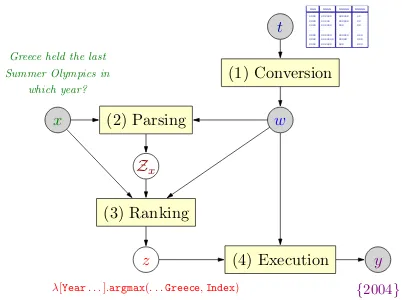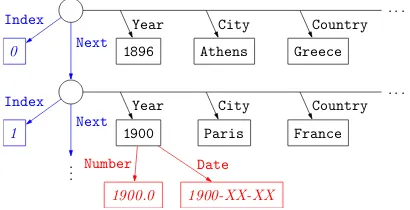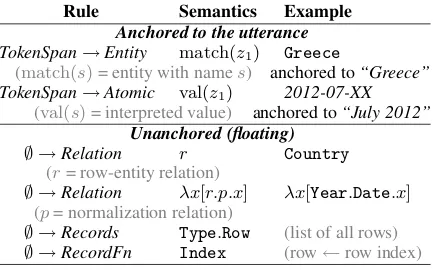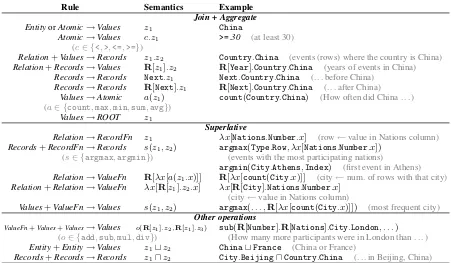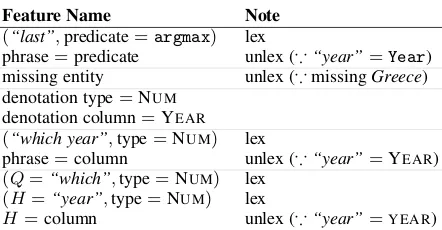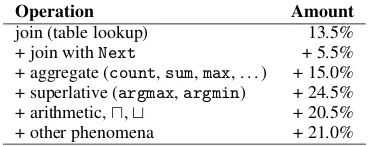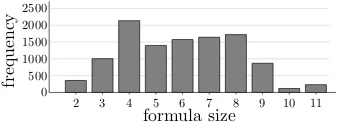Compositional Semantic Parsing on Semi-Structured Tables
Panupong Pasupat
Computer Science Department Stanford University
ppasupat@cs.stanford.edu
Percy Liang
Computer Science Department Stanford University
pliang@cs.stanford.edu
Abstract
Two important aspects of semantic pars-ing for question answerpars-ing are the breadth of the knowledge source and the depth of logical compositionality. While existing work trades off one aspect for another, this paper simultaneously makes progress on both fronts through a new task: answering complex questions on semi-structured ta-bles using question-answer pairs as super-vision. The central challenge arises from two compounding factors: the broader do-main results in an open-ended set of re-lations, and the deeper compositionality results in a combinatorial explosion in the space of logical forms. We propose a logical-form driven parsing algorithm guided by strong typing constraints and show that it obtains significant improve-ments over natural baselines. For evalua-tion, we created a new dataset of 22,033 complex questions on Wikipedia tables, which is made publicly available.
1 Introduction
In semantic parsing for question answering, nat-ural language questions are converted into logi-cal forms, which can be executed on a knowl-edge source to obtain answer denotations. Early semantic parsing systems were trained to answer highly compositional questions, but the knowl-edge sources were limited to small closed-domain databases (Zelle and Mooney, 1996; Wong and Mooney, 2007; Zettlemoyer and Collins, 2007; Kwiatkowski et al., 2011). More recent work sacrifices compositionality in favor of using more open-ended knowledge bases such as Freebase (Cai and Yates, 2013; Berant et al., 2013; Fader et al., 2014; Reddy et al., 2014). However, even these broader knowledge sources still define a
Year City Country Nations
1896 Athens Greece 14 1900 Paris France 24 1904 St. Louis USA 12 . . . . 2004 Athens Greece 201 2008 Beijing China 204
2012 London UK 204
x1:“Greece held its last Summer Olympics in which year?” y1:{2004}
x2:“In which city’s the first time with at least 20 nations?” y2:{Paris}
x3:“Which years have the most participating countries?” y3:{2008, 2012}
x4:“How many events were in Athens, Greece?” y4:{2}
x5:“How many more participants were there in 1900 than in the first year?”
y5:{10}
Figure 1: Our task is to answer a highly composi-tional question from an HTML table. We learn a semantic parser from question-table-answer triples{(xi, ti, yi)}.
rigid schema over entities and relation types, thus restricting the scope of answerable questions.
To simultaneously increase both thebreadthof the knowledge source and the depth of logical compositionality, we propose a new task (with an associated dataset): answering a question using an HTML table as the knowledge source. Figure 1 shows several question-answer pairs and an ac-companying table, which are typical of those in our dataset. Note that the questions are logically quite complex, involving a variety of operations such as comparison (x2), superlatives (x3),
aggre-gation (x4), and arithmetic (x5).
The HTML tables are semi-structured and not normalized. For example, a cell might contain multiple parts (e.g., “Beijing, China” or “200 km”). Additionally, we mandate that the train-ing and test tables are disjoint, so at test time, we will see relations (column headers; e.g., “ Na-tions”) and entities (table cells; e.g., “St. Louis”)
that were not observed during training. This is in contrast to knowledge bases like Freebase, which have a global fixed relation schema with normal-ized entities and relations.
Our task setting produces two main challenges. Firstly, the increased breadth in the knowledge source requires us to generate logical forms from novel tables with previously unseen relations and entities. We therefore cannot follow the typical semantic parsing strategy of constructing or learn-ing a lexicon that maps phrases to relations ahead of time. Secondly, the increased depth in com-positionality and additional logical operations ex-acerbate the exponential growth of the number of possible logical forms.
We trained a semantic parser for this task from question-answer pairs based on the framework il-lustrated in Figure 2. First, relations and entities from the semi-structured HTML table are encoded in a graph. Then, the system parses the question into candidate logical forms with a high-coverage grammar, reranks the candidates with a log-linear model, and then executes the highest-scoring logi-cal form to produce the answer denotation. We use beam search with pruning strategies based on type and denotation constraints to control the combina-torial explosion.
To evaluate the system, we created a new dataset, WIKITABLEQUESTIONS, consisting of 2,108 HTML tables from Wikipedia and 22,033 question-answer pairs. When tested on unseen ta-bles, the system achieves an accuracy of 37.1%, which is significantly higher than the information retrieval baseline of 12.7% and a simple semantic parsing baseline of 24.3%.
2 Task
Our task is as follows: given a tabletand a ques-tion x about the table, output a list of values y that answers the question according to the table. Example inputs and outputs are shown in Fig-ure 1. The system has access to a training set
D={(xi, ti, yi)}Ni=1 of questions, tables, and
an-swers, but the tables in test data do not appear dur-ing traindur-ing.
The only restriction on the question xis that a person must be able to answer it using just the ta-blet. Other than that, the question can be of any type, ranging from a simple table lookup question to a more complicated one that involves various logical operations.
t
(1) Conversion
x (2) Parsing w
Zx
(3) Ranking
z (4) Execution y
xxx xxxx xxxxxxxxxx
xxxx xxxx xxxx ... xxxx xxxx xxxx xxxxxx xxxxx xxxxxx ... xxxxxx xxxxxxx xxxxxx xxxxxx xxxxxx xxx ... xxxxxx xxxxx xxx xx xx xx ... xxx xxx xxx
Greece held the last Summer Olympics in
which year?
[image:2.595.315.516.60.210.2]λ[Year. . .].argmax(. . .Greece,Index) {2004}
Figure 2: The prediction framework: (1) the table tis deterministically converted into a knowledge graphw as shown in Figure 3; (2) with informa-tion fromw, the questionx is parsed into candi-date logical forms inZx; (3) the highest-scoring
candidatez∈ Zxis chosen; and (4)zis executed
onw, yielding the answery.
Dataset. We created a new dataset, WIK
-ITABLEQUESTIONS, of question-answer pairs on HTML tables as follows. We randomly selected data tables from Wikipedia with at least 8 rows and 5 columns. We then created two Amazon Mechan-ical Turk tasks. The first task asks workers to write trivia questions about the table. For each question, we put one of the 36 generic prompts such as“The question should require calculation”or“contains the word‘first’or its synonym”to encourage more complex utterances. Next, we submit the result-ing questions to the second task where the work-ers answer each question based on the given table. We only keep the answers that are agreed upon by at least two workers. After this filtering, approxi-mately 69% of the questions remains.
The final dataset contains 22,033 examples on 2,108 tables. We set aside 20% of the tables and their associated questions as the test set and de-velop on the remaining examples. Simple pre-processing was done on the tables: We omit all non-textual contents of the tables, and if there is a merged cell spanning many rows or columns, we unmerge it and duplicate its content into each un-merged cell. Section 7.2 analyzes various aspects of the dataset and compares it to other datasets.
3 Approach
Prediction. Given a table tand a question x, we predict an answer y using the framework il-lustrated in Figure 2. We first convert the table tinto a knowledge graph w(“world”) which en-codes different relations in the table (Section 4). Next, we generate a set of candidate logical forms
Zx by parsing the question x using the
informa-tion fromw(Section 6.1). Each generated logical form z ∈ Zx is a graph query that can be exe-cuted on the knowledge graphwto get a denota-tion JzKw. We extract a feature vector φ(x, w, z)
for each z ∈ Zx (Section 6.2) and define a log-linear distribution over the candidates:
pθ(z|x, w)∝exp{θ>φ(x, w, z)}, (1)
where θ is the parameter vector. Finally, we choose the logical formzwith the highest model probability and execute it onwto get the answer denotationy=JzKw.
Training. Given training examples D =
{(xi, ti, yi)}Ni=1, we seek a parameter vector θ
that maximizes the regularized log-likelihood of the correct denotation yi marginalized over
logi-cal formsz. Formally, we maximize the objective function
J(θ) = N1 XN i=1
logpθ(yi |xi, wi)−λkθk1, (2)
where wi is deterministically generated from ti,
and
pθ(y|x, w) =
X
z∈Zx;y=JzKw
pθ(z|x, w). (3)
We optimize θ using AdaGrad (Duchi et al., 2010), running 3 passes over the data. We useL1
regularization withλ = 3×10−5 obtained from
cross-validation.
The following sections explain individual sys-tem components in more detail.
4 Knowledge graph
Inspired by the graph representation of knowledge bases, we preprocess the table t by deterministi-cally converting it into a knowledge graph w as illustrated in Figure 3. In the most basic form, ta-ble rows become row nodes, strings in tata-ble cells become entity nodes,1and table columns become
directed edges from the row nodes to the entity
1Two occurrences of the same string constitute one node.
· · ·
0 1896 Athens Greece
· · ·
1 1900 Paris France
.. .
1900.0 1900-XX-XX Next
Next Index
Index
Year City Country
Year City Country
[image:3.595.312.517.66.171.2]Number Date
Figure 3: Part of the knowledge graph correspond-ing to the table in Figure 1. Circular nodes are row nodes. We augment the graph with different en-tity normalization nodes such asNumberandDate
(red) and additional row node relationsNext and
Index(blue).
nodes of that column. The column headers are used as edge labels for these row-entity relations.
The knowledge graph representation is conve-nient for three reasons. First, we can encode dif-ferent forms of entity normalization in the graph. Some entity strings (e.g., “1900”) can be inter-preted as a number, a date, or a proper name de-pending on the context, while some other strings (e.g., “200 km”) have multiple parts. Instead of committing to one normalization scheme, we in-troduce edges corresponding to different normal-ization methods from the entity nodes. For exam-ple, the node1900will have an edge calledDate
to another node1900-XX-XXof type date. Apart from type checking, these normalization nodes also aid learning by providing signals on the ap-propriate answer type. For instance, we can define a feature that associates the phrase “how many”
with a logical form that says “traverse a row-entity edge, then aNumberedge” instead of just “traverse a row-entity edge.”
The second benefit of the graph representation is its ability to handle various logical phenomena via graph augmentation. For example, to answer questions of the form“What is the next . . . ?” or
“Who came before . . . ?”, we augment each row node with an edge labeled Next pointing to the next row node, after which the questions can be answered by traversing the Next edge. In this work, we choose to add two special edges on each row node: the Next edge mentioned above and anIndexedge pointing to the row index number (0,1,2, . . .).
Name Example
Join City.Athens
(row nodes with aCityedge toAthens)
Union City.(AthenstBeijing)
Intersection City.AthensuYear.Number.<.1990 Reverse R[Year].City.Athens
(entities where a row inCity.Athenshas aYearedge to)
Aggregation count(City.Athens)
(the number of rows with cityAthens)
Superlative argmax(City.Athens,Index)
(the last row with cityAthens)
Arithmetic sub(204,201) (= 204−201)
Lambda λx[Year.Date.x]
[image:4.595.310.527.61.196.2](a binary: composition of two relations)
Table 1: The lambda DCS operations we use.
5 Logical forms
As our language for logical forms, we use lambda dependency-based compositional seman-tics (Liang, 2013), or lambda DCS, which we briefly describe here. Each lambda DCS logical form is either aunary(denoting a list of values) or abinary(denoting a list of pairs). The most basic unaries are singletons (e.g., China represents an entity node, and 30 represents a single number), while the most basic binaries are relations (e.g.,
Citymaps rows to city entities,Nextmaps rows to rows, and>=maps numbers to numbers). Log-ical forms can be combined into larger ones via various operations listed in Table 1. Each opera-tion produces a unary except lambda abstracopera-tion: λx[f(x)]is a binary mappingxtof(x).
6 Parsing and ranking
Given the knowledge graph w, we now describe how to parse the utterancexinto a set of candidate logical formsZx
6.1 Parsing algorithm
We propose a new floating parserwhich is more flexible than a standard chart parser. Both parsers recursively build up derivations and corresponding logical forms by repeatedly applying deduction rules, but the floating parser allows logical form predicates to be generated independently from the utterance.
Chart parser. We briefly review the CKY al-gorithm for chart parsing to introduce notation. Given an utterance with tokens x1, . . . , xn, the
CKY algorithm applies deduction rules of the
fol-Rule Semantics Example
Anchored to the utterance
TokenSpan→Entity match(z1) Greece
(match(s)= entity with names) anchored to“Greece”
TokenSpan→Atomic val(z1) 2012-07-XX
(val(s)= interpreted value) anchored to“July 2012”
Unanchored (floating)
∅ →Relation r Country
(r= row-entity relation)
∅ →Relation λx[r.p.x] λx[Year.Date.x]
(p= normalization relation)
∅ →Records Type.Row (list of all rows)
[image:4.595.74.293.62.204.2]∅ →RecordFn Index (row←row index)
Table 2: Base deduction rules. Entities and atomic values (e.g., numbers, dates) are anchored to to-ken spans, while other predicates are kept floating. (a←brepresents a binary mappingbtoa.)
lowing two kinds:
(TokenSpan, i, j)[s]→(c, i, j)[f(s)], (4)
(c1, i, k)[z1] + (c2, k+ 1, j)[z2] (5)
→(c, i, j)[f(z1, z2)].
The first rule is a lexical rule that matches an utter-ance token spanxi· · ·xj (e.g.,s =“New York”)
and produces a logical form (e.g., f(s) = NewYorkCity) with category c (e.g., Entity). The second rule takes two adjacent spans giv-ing rise to logical forms z1 and z2 and builds a
new logical formf(z1, z2). Algorithmically, CKY
stores derivations of categoryccovering the span xi· · ·xj in acell(c, i, j). CKY fills in the cells of
increasing span lengths, and the logical forms in the top cell(ROOT,1, n)are returned.
Floating parser. Chart parsing uses lexical rules (4) to generate relevant logical predicates, but in our setting of semantic parsing on tables, we do not have the luxury of starting with or inducing a full-fledged lexicon. Moreover, there is a mismatch between words in the utterance and predicates in the logical form. For in-stance, consider the question “Greece held its last Summer Olympics in which year?” on the table in Figure 1 and the correct logical form
R[λx[Year.Date.x]].argmax(Country.Greece,Index).
While the entity Greece can be anchored to the token “Greece”, some logical predicates (e.g.,
Rule Semantics Example
Join + Aggregate
EntityorAtomic→Values z1 China
Atomic→Values c.z1 >=.30 (at least 30) (c∈ {<,>,<=,>=})
Relation+Values→Records z1.z2 Country.China (events (rows) where the country is China)
Relation+Records→Values R[z1].z2 R[Year].Country.China (years of events in China)
Records→Records Next.z1 Next.Country.China (. . . before China)
Records→Records R[Next].z1 R[Next].Country.China (. . . after China)
Values→Atomic a(z1) count(Country.China) (How often did China . . . ) (a∈ {count,max,min,sum,avg})
Values→ROOT z1
Superlative
Relation→RecordFn z1 λx[Nations.Number.x] (row←value in Nations column)
Records+RecordFn→Records s(z1, z2) argmax(Type.Row, λx[Nations.Number.x]) (s∈ {argmax,argmin}) (events with the most participating nations)
argmin(City.Athens,Index) (first event in Athens)
Relation→ValueFn R[λx[a(z1.x)]] R[λx[count(City.x)]] (city←num. of rows with that city)
Relation+Relation→ValueFn λx[R[z1].z2.x] λx[R[City].Nations.Number.x]
(city←value in Nations column)
Values+ValueFn→Values s(z1, z2) argmax(. . . ,R[λx[count(City.x)]]) (most frequent city)
Other operations
ValueFn+Values+Values→Values o(R[z1].z2,R[z1].z3) sub(R[Number].R[Nations].City.London, . . .)
(o∈ {add,sub,mul,div}) (How many more participants were in London than . . . )
Entity+Entity→Values z1tz2 ChinatFrance (China or France)
[image:5.595.73.524.60.323.2]Records+Records→Records z1uz2 City.BeijinguCountry.China (. . . in Beijing, China)
Table 3: Compositional deduction rules. Each rulec1, . . . , ck → ctakes logical formsz1, . . . , zk
con-structed over categoriesc1, . . . , ck, respectively, and produces a logical form based on the semantics.
(e.g., “Olympics”) are irrelevant and have no predicates anchored to them.
Therefore, instead of anchoring each predicate in the logical form to tokens in the utterance via lexical rules, we propose parsing more freely. We replace the anchored cells (c, i, j) with floating cells(c, s) of categoryc and logical form sizes. Then we apply rules of the following three kinds:
(TokenSpan, i, j)[s]→(c,1)[f(s)], (6)
∅ →(c,1)[f()], (7)
(c1, s1)[z1] + (c2, s2)[z2] (8)
→(c, s1+s2+ 1)[f(z1, z2)].
Note that rules (6) are similar to (4) in chart parsing except that the floating cell (c,1) only keeps track of the category and its size 1, not the span (i, j). Rules (7) allow us to construct predicates out of thin air. For example, we can construct a logical form representing a table rela-tion Country in cell (Relation,1) using the rule
∅ → Relation[Country] independent of the ut-terance. Rules (8) perform composition, where the induction is on the size sof the logical form rather than the span length. The algorithm stops when the specified maximum size is reached, after which the logical forms in cells(ROOT, s)for any sare included inZx. Figure 4 shows an example derivation generated by our floating parser.
(Values,8)
R[λx[Year.Date.x]].argmax(Country.Greece,Index)
(Relation,1) λx[Year.Date.x]
(Records,6)
argmax(Country.Greece,Index)
(Records,4) Country.Greece
(Relation,1) Country
(Values,2) Greece
(Entity,1) Greece
(TokenSpan,1,1) “Greece”
[image:5.595.308.523.389.574.2](RecordFn,1) Index
Figure 4: A derivation for the utterance “Greece held its last Summer Olympics in which year?”
OnlyGreece is anchored to a phrase“Greece”;
Yearand other predicates are floating.
The floating parser is very flexible: it can skip tokens and combine logical forms in any order. This flexibility might seem too unconstrained, but we can use strong typing constraints to prevent nonsensical derivations from being constructed.
an-“Greece held its last Summer Olympics in which year?”
z=R[λx[Year.Number.x]].argmax(Type.Row,Index)
y={2012}(type: NUM, column: YEAR) Feature Name Note
(“last”,predicate=argmax) lex
phrase=predicate unlex (∵“year”=Year) missing entity unlex (∵missingGreece) denotation type=NUM
denotation column=YEAR (“which year”,type=NUM) lex
phrase=column unlex (∵“year”=YEAR)
(Q=“which”,type=NUM) lex (H=“year”,type=NUM) lex
[image:6.595.73.294.93.208.2]H =column unlex (∵“year”=YEAR)
Table 4: Example features that fire for the (incor-rect) logical formz. All features are binary. (lex = lexicalized)
chor all entity predicates (e.g., Greece) to token spans (e.g.,“Greece”). We also anchor all numer-ical values (numbers, dates, percentages, etc.) de-tected by an NER system. In contrast, relations (e.g.,Country) and operations (e.g.,argmax) are kept floating since we want to learn how they are expressed in language. Connections between phrases in x and the generated relations and op-erations inzare established in the ranking model through features.
6.2 Features
We define features φ(x, w, z) for our log-linear model to capture the relationship between the question x and the candidate z. Table 4 shows some example features from each feature type. Most features are of the form (f(x), g(z)) or
(f(x), h(y)) where y = JzKw is the denotation,
and f, g, and h extract some information (e.g., identity, POS tags) fromx,z, ory, respectively.
phrase-predicate: Conjunctions between n-grams f(x) from x and predicates g(z) from z. We use both lexicalized features, where all possi-ble pairs(f(x), g(z))form distinct features, and binary unlexicalized features indicating whether f(x)andg(z)have a string match.
missing-predicate:Indicators on whether there are entities or relations mentioned inxbut not in z. These features are unlexicalized.
denotation: Size and type of the denotation y =JxKw. The type can be either a primitive type
(e.g., NUM, DATE, ENTITY) or the name of the column containing the entity iny(e.g., CITY).
phrase-denotation: Conjunctions between n-grams from x and the types of y. Similar to the phrase-predicate features, we use both lexicalized
and unlexicalized features.
headword-denotation: Conjunctions between the question wordQ(e.g.,what,who,how many) or the headwordH (the first noun after the ques-tion word) with the types ofy.
6.3 Generation and pruning
Due to their recursive nature, the rules allow us to generate highly compositional logical forms. However, the compositionality comes at the cost of generating exponentially many logical forms, most of which are redundant (e.g., logical forms with anargmaxoperation on a set of size 1). We employ several methods to deal with this combi-natorial explosion:
Beam search. We compute the model
proba-bility of each partial logical form based on avail-able features (i.e., features that do not depend on the final denotation) and keep only theK = 200
highest-scoring logical forms in each cell.
Pruning. We prune partial logical forms that lead to invalid or redundant final logical forms. For example, we eliminate any logical form that does not type check (e.g., Beijing tGreece), executes to an empty list (e.g.,Year.Number.24), includes an aggregate or superlative on a singleton set (e.g.,argmax(Year.Number.2012,Index)), or joins two relations that are the reverses of each other (e.g.,R[City].City.Beijing).
7 Experiments
7.1 Main evaluation
We evaluate the system on the development sets (three random 80:20 splits of the training data) and the test data. In both settings, the tables we test on do not appear during training.
Evaluation metrics. Our main metric is accu-racy, which is the number of examples (x, t, y)
on which the system outputs the correct answery. We also report theoraclescore, which counts the number of examples where at least one generated candidatez∈ Zxexecutes toy.
dev test
acc ora acc ora
[image:7.595.324.510.61.134.2]IR baseline 13.4 69.1 12.7 70.6 WQ baseline 23.6 34.4 24.3 35.6 Our system 37.0 76.7 37.1 76.6 Table 5: Accuracy (acc) and oracle scores (ora) on the development sets (3 random splits of the training data) and the test data.
acc ora Our system 37.0 76.7 (a) Rule Ablation
join only 10.6 15.7
join + count (= WQ baseline) 23.6 34.4 join + count + superlative 30.7 68.6
all− {u,t} 34.8 75.1
(b) Feature Ablation
all−features involving predicate 11.8 74.5 all−phrase-predicate 16.9 74.5 all−lex phrase-predicate 17.6 75.9 all−unlex phrase-predicate 34.3 76.7 all−missing-predicate 35.9 76.7 all−features involving denotation 33.5 76.8
all−denotation 34.3 76.6
[image:7.595.87.280.64.129.2]all−phrase-denotation 35.7 76.8 all−headword-denotation 36.0 76.7 (c) Anchor operations to trigger words 37.1 59.4 Table 6: Average accuracy and oracle scores on development data in various system settings.
69.1% of the development examples have the an-swer appearing as an entity in the table.
In the second baseline (WQ), we only allow de-duction rules that produce join and count logical forms. This rule subset has the same logical cov-erage as Berant and Liang (2014), which is de-signed to handle the WEBQUESTIONS(Berant et al., 2013) and FREE917 (Cai and Yates, 2013) datasets.
Results. Table 5 shows the results compared to the baselines. Our system gets an accuracy of 37.1% on the test data, which is significantly higher than both baselines, while the oracle is 76.6%. The next subsections analyze the system components in more detail.
7.2 Dataset statistics
In this section, we analyze the breadth and depth of the WIKITABLEQUESTIONS dataset, and how the system handles them.
Number of relations. With 3,929 unique col-umn headers (relations) among 13,396 colcol-umns, the tables in the WIKITABLEQUESTIONSdataset contain many more relations than closed-domain datasets such as Geoquery (Zelle and Mooney,
Operation Amount
join (table lookup) 13.5%
+ join withNext + 5.5%
+ aggregate (count,sum,max, . . . ) + 15.0% + superlative (argmax,argmin) + 24.5% + arithmetic,u,t + 20.5%
+ other phenomena + 21.0%
Table 7: The logical operations required to answer the questions in 200 random examples.
1996) and ATIS (Price, 1990). Additionally, the logical forms that execute to the correct denota-tions refer to a total of 2,056 unique column head-ers, which is greater than the number of relations in the FREE917 dataset (635 Freebase relations).
Knowledge coverage. We sampled 50
exam-ples from the dataset and tried to answer them manually using Freebase. Even though Free-base contains some information extracted from Wikipedia, we can answer only 20% of the ques-tions, indicating that WIKITABLEQUESTIONS contains a broad set of facts beyond Freebase.
Logical operation coverage. The dataset cov-ers a wide range of question types and logical operations. Table 6(a) shows the drop in oracle scores when different subsets of rules are used to generate candidates logical forms. Thejoin only
subset corresponds to simple table lookup, while
join + countis the WQ baseline for Freebase ques-tion answering on the WEBQUESTIONS dataset. Finally,join + count + superlativeroughly corre-sponds to the coverage of the Geoquery dataset.
To better understand the distribution of log-ical operations in the WIKITABLEQUESTIONS dataset, we manually classified 200 examples based on the types of operations required to an-swer the question. The statistics in Table 7 shows that while a few questions only require simple operations such as table lookup, the majority of the questions demands more advanced operations. Additionally, 21% of the examples cannot be an-swered using any logical form generated from the current deduction rules; these examples are dis-cussed in Section 7.4.
Compositionality. From each example, we
compute the logical form size (number of rules applied) of the highest-scoring candidate that exe-cutes to the correct denotation. The histogram in Figure 5 shows that a significant number of logical forms are non-trivial.
[image:7.595.73.288.191.371.2]2 3 4 5 6 7 8 9 10 11
formula size
0 500 1000 1500 2000 2500
[image:8.595.98.267.63.124.2]frequency
Figure 5: Sizes of the highest-scoring correct can-didate logical forms in development examples.
with pruning without pruning
0 25 50 75 100 beam size 0
20 40 60 80
score
0 25 50 75 100 beam size 0
20 40 60 80
[image:8.595.90.276.174.243.2]score
Figure 6: Accuracy (solid red) and oracle (dashed blue) scores with different beam sizes.
sizes. Apart from saving time, pruning also pre-vents bad logical forms from clogging up the beam which hurts both oracle and accuracy metrics.
7.3 Features
Effect of features. Table 6(b) shows the accu-racy when some feature types are ablated. The most influential features are lexicalized phrase-predicate features, which capture the relationship between phrases and logical operations (e.g., relat-ing“last”toargmax) as well as between phrases and relations (e.g., relating“before”to<orNext, and relating“who”to the relationName).
Anchoring with trigger words. In our parsing algorithm, relations and logical operations are not anchored to the utterance. We consider an alter-native approach where logical operations are an-chored to “trigger” phrases, which are hand-coded based on co-occurrence statistics (e.g., we trigger acountlogical form withhow,many, andtotal).
Table 6(c) shows that the trigger words do not significantly impact the accuracy, suggesting that the original system is already able to learn the re-lationship between phrases and operations even without a manual lexicon. As an aside, the huge drop in oracle is because fewer “semantically in-correct” logical forms are generated; we discuss this phenomenon in the next subsection.
7.4 Semantically correct logical forms
In our setting, we face a new challenge that arises from learning with denotations: with deeper com-positionality, a larger number of nonsensical log-ical forms can execute to the correct denotation.
For example, if the target answer is a small num-ber (say, 2), it is possible to count the numnum-ber of rows with some random properties and arrive at the correct answer. However, as the system en-counters more examples, it can potentially learn to disfavor them by recognizing the characteristics of semantically correct logical forms.
Generating semantically correct logical forms. The system can learn the features of semantically correct logical forms only if it can generate them in the first place. To see how well the system can generate correct logical forms, looking at the oracle score is insufficient since bad logical forms can execute to the correct denotations. Instead, we randomly chose 200 ex-amples and manually annotated them with logical forms to see if a trained system can produce the annotated logical form as a candidate.
Out of 200 examples, we find that 79% can be manually annotated. The remaining ones in-clude artifacts such as unhandled question types (e.g., yes-no questions, or questions with phrases
“same”or“consecutive”), table cells that require advanced normalization methods (e.g., cells with comma-separated lists), and incorrect annotations. The system generates the annotated logical form among the candidates in 53.5% of the ex-amples. The missing examples are mostly caused by anchoring errors due to lexical mismatch (e.g.,
“Italian”→Italy, or“no zip code”→an empty cell in the zip code column) or the need to generate complex logical forms from a single phrase (e.g.,
“May 2010”→>=.2010-05-01u<=.2010-05-31).
7.5 Error analysis
8 Discussion
Our work simultaneously increases the breadth of knowledge source and the depth of compositional-ity in semantic parsing. This section explores the connections in both aspects to related work.
Logical coverage. Different semantic parsing systems are designed to handle different sets of logical operations and degrees of compositional-ity. For example, form-filling systems (Wang et al., 2011) usually cover a smaller scope of opera-tions and compositionality, while early statistical semantic parsers for question answering (Wong and Mooney, 2007; Zettlemoyer and Collins, 2007) and high-accuracy natural language inter-faces for databases (Androutsopoulos et al., 1995; Popescu et al., 2003) target more compositional utterances with a wide range of logical opera-tions. This work aims to increase the logical coverage even further. For example, compared to the Geoquery dataset, the WIKITABLEQUES -TIONSdataset includes a move diverse set of log-ical operations, and while it does not have ex-tremely compositional questions like in Geoquery (e.g.,“What states border states that border states that border Florida?”), our dataset contains fairly compositional questions on average.
To parse a compositional utterance, many works rely on a lexicon that translates phrases to enti-ties, relations, and logical operations. A lexicon can be automatically generated (Unger and Cimi-ano, 2011; Unger et al., 2012), learned from data (Zettlemoyer and Collins, 2007; Kwiatkowski et al., 2011), or extracted from external sources (Cai and Yates, 2013; Berant et al., 2013), but requires some techniques to generalize to unseen data. Our work takes a different approach similar to the log-ical form growing algorithm in Berant and Liang (2014) by not anchoring relations and operations to the utterance.
Knowledge domain. Recent works on
seman-tic parsing for question answering operate on more open and diverse data domains. In particular, large-scale knowledge bases have gained popular-ity in the semantic parsing communpopular-ity (Cai and Yates, 2013; Berant et al., 2013; Fader et al., 2014). The increasing number of relations and en-tities motivates new resources and techniques for improving the accuracy, including the use of ontol-ogy matching models (Kwiatkowski et al., 2013), paraphrase models (Fader et al., 2013; Berant and Liang, 2014), and unlabeled sentences
(Krishna-murthy and Kollar, 2013; Reddy et al., 2014). Our work leverages open-ended data from the Web through semi-structured tables. There have been several studies on analyzing or inferring the table schemas (Cafarella et al., 2008; Venetis et al., 2011; Syed et al., 2010; Limaye et al., 2010) and answering search queries by joining tables on sim-ilar columns (Cafarella et al., 2008; Gonzalez et al., 2010; Pimplikar and Sarawagi, 2012). While the latter is similar to question answering, the queries tend to be keyword lists instead of natural language sentences. In parallel, open information extraction (Wu and Weld, 2010; Masaum et al., 2012) and knowledge base population (Ji and Gr-ishman, 2011) extract information from web pages and compile them into structured data. The result-ing knowledge base is systematically organized, but as a trade-off, some knowledge is inevitably lost during extraction and the information is forced to conform to a specific schema. To avoid these is-sues, we choose to work on HTML tables directly. In future work, we wish to draw informa-tion from other semi-structured formats such as colon-delimited pairs (Wong et al., 2009), bulleted lists (Gupta and Sarawagi, 2009), and top-k lists (Zhang et al., 2013). Pasupat and Liang (2014) used a framework similar to ours to extract entities from web pages, where the “logical forms” were XPath expressions. A natural direction is to com-bine the logical compositionality of this work with the even broader knowledge source of general web pages.
Acknowledgements. We gratefully
acknowl-edge the support of the Google Natural Language Understanding Focused Program and the Defense Advanced Research Projects Agency (DARPA) Deep Exploration and Filtering of Text (DEFT) Program under Air Force Research Laboratory (AFRL) contract no. FA8750-13-2-0040.
Data and reproducibility. The WIKITABLE -QUESTIONS dataset can be downloaded at http:
//nlp.stanford.edu/software/sempre/wikitable/.
Additionally, code, data, and experiments for this paper are available on the CodaLab plat-form at https://www.codalab.org/worksheets/
0xf26cd79d4d734287868923ad1067cf4c/.
References
an introduction. Journal of Natural Language En-gineering, 1:29–81.
J. Berant and P. Liang. 2014. Semantic parsing via
paraphrasing. In Association for Computational
Linguistics (ACL).
J. Berant, A. Chou, R. Frostig, and P. Liang. 2013. Semantic parsing on Freebase from question-answer
pairs. InEmpirical Methods in Natural Language
Processing (EMNLP).
M. J. Cafarella, A. Halevy, D. Z. Wang, E. Wu, and Y. Zhang. 2008. WebTables: exploring the power
of tables on the web. In Very Large Data Bases
(VLDB), pages 538–549.
Q. Cai and A. Yates. 2013. Large-scale semantic pars-ing via schema matchpars-ing and lexicon extension. In Association for Computational Linguistics (ACL). J. Duchi, E. Hazan, and Y. Singer. 2010. Adaptive
sub-gradient methods for online learning and stochastic
optimization. In Conference on Learning Theory
(COLT).
A. Fader, L. Zettlemoyer, and O. Etzioni. 2013.
Paraphrase-driven learning for open question
an-swering. InAssociation for Computational
Linguis-tics (ACL).
A. Fader, L. Zettlemoyer, and O. Etzioni. 2014.
Open question answering over curated and extracted
knowledge bases. In International Conference on
Knowledge Discovery and Data Mining (KDD), pages 1156–1165.
H. Gonzalez, A. Y. Halevy, C. S. Jensen, A. Langen, J. Madhavan, R. Shapley, W. Shen, and J. Goldberg-Kidon. 2010. Google fusion tables: web-centered
data management and collaboration. InProceedings
of the 2010 ACM SIGMOD International Confer-ence on Management of data, pages 1061–1066. R. Gupta and S. Sarawagi. 2009. Answering table
augmentation queries from unstructured lists on the
web. InVery Large Data Bases (VLDB), number 1,
pages 289–300.
H. Ji and R. Grishman. 2011. Knowledge base pop-ulation: Successful approaches and challenges. In Association for Computational Linguistics (ACL), pages 1148–1158.
J. Krishnamurthy and T. Kollar. 2013. Jointly learning to parse and perceive: Connecting natural language to the physical world. Transactions of the Associa-tion for ComputaAssocia-tional Linguistics (TACL), 1:193– 206.
T. Kwiatkowski, L. Zettlemoyer, S. Goldwater, and M. Steedman. 2011. Lexical generalization in CCG grammar induction for semantic parsing. In Empirical Methods in Natural Language Processing (EMNLP), pages 1512–1523.
T. Kwiatkowski, E. Choi, Y. Artzi, and L. Zettlemoyer. 2013. Scaling semantic parsers with the-fly
on-tology matching. InEmpirical Methods in Natural
Language Processing (EMNLP).
P. Liang. 2013. Lambda dependency-based composi-tional semantics. arXiv.
G. Limaye, S. Sarawagi, and S. Chakrabarti. 2010. Annotating and searching web tables using entities,
types and relationships. InVery Large Data Bases
(VLDB), volume 3, pages 1338–1347.
Masaum, M. Schmitz, R. Bart, S. Soderland, and O. Et-zioni. 2012. Open language learning for
informa-tion extracinforma-tion. In Empirical Methods in Natural
Language Processing and Computational Natural Language Learning (EMNLP/CoNLL), pages 523– 534.
P. Pasupat and P. Liang. 2014. Zero-shot entity
extrac-tion from web pages. InAssociation for
Computa-tional Linguistics (ACL).
R. Pimplikar and S. Sarawagi. 2012. Answering table
queries on the web using column keywords. InVery
Large Data Bases (VLDB), volume 5, pages 908– 919.
A. Popescu, O. Etzioni, and H. Kautz. 2003. Towards a theory of natural language interfaces to databases. In International Conference on Intelligent User In-terfaces (IUI), pages 149–157.
P. Price. 1990. Evaluation of spoken language
sys-tems: The ATIS domain. In Proceedings of the
Third DARPA Speech and Natural Language Work-shop, pages 91–95.
S. Reddy, M. Lapata, and M. Steedman. 2014. Large-scale semantic parsing without question-answer
pairs. Transactions of the Association for
Compu-tational Linguistics (TACL), 2(10):377–392. Z. Syed, T. Finin, V. Mulwad, and A. Joshi. 2010.
Exploiting a web of semantic data for interpreting
tables. In Proceedings of the Second Web Science
Conference.
C. Unger and P. Cimiano. 2011. Pythia: compositional meaning construction for ontology-based question
answering on the semantic web. InProceedings of
the 16th international conference on Natural lan-guage processing and information systems, pages 153–160.
C. Unger, L. B¨uhmann, J. Lehmann, A. Ngonga, D. Gerber, and P. Cimiano. 2012. Template-based
question answering over RDF data. InWorld Wide
Web (WWW), pages 639–648.
P. Venetis, A. Halevy, J. Madhavan, M. Pas¸ca, W. Shen, F. Wu, G. Miao, and C. Wu. 2011. Recovering
se-mantics of tables on the web. InVery Large Data
Y. Wang, L. Deng, and A. Acero. 2011. Semantic
frame-based spoken language understanding.
Spo-ken Language Understanding: Systems for Extract-ing Semantic Information from Speech, pages 41–91. Y. W. Wong and R. J. Mooney. 2007. Learning synchronous grammars for semantic parsing with
lambda calculus. InAssociation for Computational
Linguistics (ACL), pages 960–967.
Y. W. Wong, D. Widdows, T. Lokovic, and K. Nigam. 2009. Scalable attribute-value extraction from
semi-structured text. In IEEE International Conference
on Data Mining Workshops, pages 302–307. F. Wu and D. S. Weld. 2010. Open information
extrac-tion using Wikipedia. InAssociation for
Computa-tional Linguistics (ACL), pages 118–127.
M. Zelle and R. J. Mooney. 1996. Learning to parse database queries using inductive logic
pro-gramming. InAssociation for the Advancement of
Artificial Intelligence (AAAI), pages 1050–1055. L. S. Zettlemoyer and M. Collins. 2007. Online
learn-ing of relaxed CCG grammars for parslearn-ing to
log-ical form. In Empirical Methods in Natural
guage Processing and Computational Natural Lan-guage Learning (EMNLP/CoNLL), pages 678–687. Z. Zhang, K. Q. Zhu, H. Wang, and H. Li. 2013.
